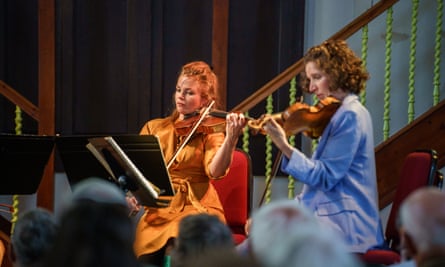Saint Magnus’s death began the first ever St Magnus festival in 1977 with Peter Maxwell Davies’s opera The Martyrdom of St Magnus. His birth opens the 2023 festival in David McNeish’s powerful if static new play, Thora, gives a voice to the mother of the patron saint of Orkney. Magnificently brought to life by Isabella Jarrett, Thora, in her old age, tells her own story including the brutal rape that begat her son, whose own life ended in violence and whose skull is in Kirkwall’s 12th cathedral that bears his name.
The St Magnus festival was co-founded by Maxwell Davies, Orcadian poet George Mackay Brown, arts campaigner Marjorie Linklater and Norman Mitchell, music teacher and cathedral organist. Ticket sales have always been split equally between visitors and residents, but the local community was and remains at its heart, and the islands’ rich past is a tangible part of the midsummer festival, which takes in classical, contemporary and traditional music, literature and dance as well as drama.
For Maxwell Davies, education was key. Alasdair Nicolson, director since 2010, has broadened that focus to the wider community.
“In the earliest days of this festival music education wasn’t really a thing,” he tells me, “and to go into schools was quite novel. But the landscape has changed – there is more activity in school education these days. Now every orchestra, theatre and ballet company is out doing work in education all year round. There’s also the issue that it’s no longer straightforward to ask a class to clear their timetables to do a show.” Under Nicolson, the festival has worked with groups including autistic children, undertaken a photography project with Women’s Aid, and most recently there has been a collaboration with Age Scotland Orkney working with dementia patients.
Volunteers – well over 100 of them – are the welcoming and friendly faces of every festival experience, without whom nothing could function. “They’re council workers, lawyers, all sorts – most take a week’s holiday to do this,” says Nicolson. The 90-strong St Magnus Festival Chorus, meanwhile, is an un-auditioned group drawn from the local community. In the austere beauties of the 12th-century St Magnus Cathedral they performed a thoughtful programme that interspersed Orcadian poetry with songs ranging from Gibbons to Whitacre before Fauré’s Requiem.
“I like to mix art forms or programme events where the walls come down a little, so that things don’t feel too stuffy and you’re brought in,” says Nicolson. “Festivals have to be slightly different and magical, otherwise what’s the point if you only do the repertoire that everyone does.”

Over eight days, 34 events are spread across 13 venues on Orkney’s mainland as well as the smaller islands of Hoy, South Ronaldsay and Shapinsay. St Nicholas irk in Holm, the south-east corner of the mainland, is a disused church that’s been bought by local people who didn’t want to see it become ruins; housing events gives it new life and might help with accessing funds for renovation. Saturday’s concert with the exciting young Scottish cellist Findlay Spence involved a 30-minute ferry crossing to Hoy (where Maxwell Davies lived for many years), then a recital in the pump room of the fascinating Scapa Flow museum (a finalist for this year’s Museum of the Year) before a minibus ride across the glorious landscape to Hoy Kirk for soup and sandwiches made and served by local people, and a longer recital pairing Britten’s intensely personal Cello Suite No3 with Beamish’s Gala Water and Ukrainian composer Silvestrov’s In Memoriam JS Bach. Spence is an engaging and profoundly musical performer, taking time to introduce each work beforehand.
The Dutch Ragazze Quartet, likewise, spoke to their audience at their afternoon recital in Stromness town hall, a programme of Mozart, Widmann and Schubert (a blistering performance of Death and the Maiden). It’s an approach that pays huge dividends, particularly in helping an audience to engage with contemporary music. “You’re going to hear us make unusual sounds,” warned violinist Jeanita Vriens-van Tongeren ahead of the Widmann, demonstrating the bow on wood sound, the swish of it slicing through the air, and even the scored noise of the quartet’s inhalations and exhalations, all part of his 4th String Quartet.

The festival has always positioned emerging artists, says Nicolson, who also cites Dutch pianist Nikola Meeuwsen as among the names to watch. “Sometimes I feel like it’s a bit like being a football scout. Come to my world before I can’t afford you!” he laughs. Previous performers who came at the beginning of their now stellar careers have included Sean Shibe, Pavel Kolesnikov and Samson Tsoy, and a teenage Nicola Benedetti.
Contemporary music is less of a presence than it was in Maxwell Davies’s day; this year’s festival features only a single premiere, from the Scottish composer Pàdruig Morrison. “Max’s music comes and goes from the programming when it’s appropriate,” says Nicolson. “I want to do things that aren’t just a token throw in; things that aren’t done very often, such as the Medium that was performed last year, a 50-minute unaccompanied monodrama for soprano. It’s an extraordinary and fascinating piece but very rarely done.”
But Max’s love of and honouring of his community is evident in every corner of the festival. Each performer is booked for two or three events, there are chamber music collaborations, and the Fauré Requiem’s scratch orchestra included Hebrides Ensemble musicians alongside Spence and Friend on cello. “There’s no point coming here just to do one thing. Blowing in and out doesn’t work – financially! Performers get all that, and they live and play here for these two or three days alongside their audience. That’s the joy of the thing. Everyone is part of the community,” says Nicolson.

